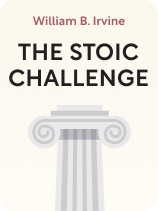

This article is an excerpt from the Shortform book guide to "The Stoic Challenge" by William B. Irvine. Shortform has the world's best summaries and analyses of books you should be reading.
Like this article? Sign up for a free trial here.
Do you know how to face difficulties in life? How would a Stoic approach failure and death?
William B. Irvine says there are three key areas of life where you can apply Stoic strategies for overcoming adversity. Namely, he discusses how to approach failure, falls from high places, and death as a Stoic would.
Here are the three difficult areas of life where you need to embrace your inner Stoic.
1. Approach Failure as an Opportunity to Learn
Irvine suggests that you use the Stoics’ method of reframing to learn how to face difficulties in life. Specifically, he suggests that you reframe failures—which most of us perceive and thereby experience as adverse events—as learning opportunities.
If you never acknowledge your mistakes and failures, Irvine argues, you’ll never learn anything. This is because our failures show us exactly what we did wrong and, in this way, suggest what we need to do differently to improve the next time around. Failure, then, is profoundly useful. In fact, it’s a core ingredient of success. According to Irvine, anyone who achieves anything of note does so not in spite of failure, but because they learn from their failures. This is true of world-class athletes, entrepreneurs who change the world, parents who raise good humans, professional musicians, and anyone else who’s succeeded.
| Learning Derives From Failure Much as Irvine discusses above, Matthew Syed argues throughout Black Box Thinking that failure is the key ingredient in learning and that it drives human progress on both the personal and systemic levels. Like Irvine, he says that examining our failures reveals the gap between our knowledge and reality—for instance, reviewing a poorly shot arrow can tell you much about how to improve your form and hit the target. Or, reflecting on a botched business presentation (not to mention getting feedback) will help you do better next time. This may seem obvious, but it’s easier said than done. Both Irvine and Syed agree that to make better use of failure, we need to change our mindsets. Practical strategies to achieve this include meditation, which can help you stay calmer when you mess up, and noting positives that have resulted from past failures. |
Irvine recommends that to embrace failure, you should break your goals into actionable steps and anticipatable obstacles. Then, take action, make mistakes, learn from them, and push ahead. You’ll either succeed or fall short having learned a lot. And if you fail, don’t worry—it’s better to have tried and failed than to have never tried at all. (Shortform note: Beyond simply taking action, Robert Greene argues that you can more effectively learn by engaging in hands-on practice: Find a mentor or guide, then commit to following that person’s lead, building momentum, and staying the course.)
2. Approach the Loss of Good Fortune With Grace and Humility
Next, Irvine turns to what he calls a particularly pernicious form of adversity—when things are going well, you’re high on success and good fortune, and then suddenly everything takes a catastrophic turn.

———End of Preview———
Like what you just read? Read the rest of the world's best book summary and analysis of William B. Irvine's "The Stoic Challenge" at Shortform.
Here's what you'll find in our full The Stoic Challenge summary:
- How you can minimize suffering by reframing it
- How you can use the Stoics’ strategy in your everyday life
- Why you should take any good fortune in stride






